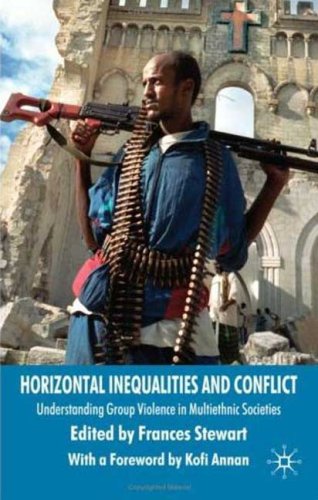

Most ebook files are in PDF format, so you can easily read them using various software such as Foxit Reader or directly on the Google Chrome browser.
Some ebook files are released by publishers in other formats such as .awz, .mobi, .epub, .fb2, etc. You may need to install specific software to read these formats on mobile/PC, such as Calibre.
Please read the tutorial at this link: https://ebookbell.com/faq
We offer FREE conversion to the popular formats you request; however, this may take some time. Therefore, right after payment, please email us, and we will try to provide the service as quickly as possible.
For some exceptional file formats or broken links (if any), please refrain from opening any disputes. Instead, email us first, and we will try to assist within a maximum of 6 hours.
EbookBell Team

5.0
70 reviews
ISBN 10: 0230245501
ISBN 13: 9780230245501
Author: F Stewart
Drawing on econometric evidence and in-depth studies of West Africa, Latin America and Southeast Asia, this book explores how horizontal inequalities - ethnic, religious or racial - are a source of violent conflict and how political, economic and cultural status inequalities have contributed. Policies to reverse inequality would reduce these risks.
Part I Concepts and Issues
1 Horizontal Inequalities and Conflict: An Introduction and some Hypotheses
1.1 Introduction
1.2 Groups in conflict
1.3 Group formation and mobilization
1.4 Horizontal inequalities and mobilization
1.5 Horizontal inequalities and conflict: The main hypotheses
1.6 Plan of this book
2 Who Should be Included? Noncitizens, Conflict and the Constitution of the Citizenry
2.1 Introduction
2.2 The scope of the analysis
2.3 The creation of noncitizenship
2.4 The reproduction of noncitizenship
2.5 Citizenship as a focus of concern
2.6 Just principles for accessing citizenship
2.7 Conclusion
3 Cultural Status Inequalities: An Important Dimension of Group Mobilization
3.1 Introduction
3.2 Conceptualizing cultural status inequalities
3.3 Three aspects of cultural status inequality
3.4 Status anxiety: Linking cultural status inequalities, mobilization and conflict
3.5 Conclusions
4 Horizontal Inequalities: Explaining Persistence and Change
4.1 Introduction
4.2 A framework for considering the evolution of horizontal inequalities
4.3 Evidence for the persistence and change of horizontal inequalities
4.4 Conclusions and policy implications
Part II Measurement and Statistical Analysis
5 Approaches to the Measurement of Horizontal Inequalities
5.1 Introduction
5.2 Problems of measuring horizontal inequalities
5.3 Measuring horizontal inequalities at an aggregate level
5.4 Applications of the aggregate measures: South Africa, the United States, and Indonesia
5.5 Measuring horizontal inequalities in different segments of the income distribution
5.6 Some conclusions
Appendix 5A
6 Horizontal Inequality and Communal Violence: Evidence from Indonesian Districts
6.1 Introduction
6.2 Operationalizing ethnicity: Three approaches
6.3 Previous quantitative literature on horizontal inequality
6.4 The Indonesian context
6.5 Methodology
6.6 Data
6.7 Sample and summary statistics
6.8 Results
6.9 Conclusions
Appendix 6A
7 Inequalities, the Political Environment and Civil Conflict: Evidence from 55 Developing Countries
7.1 Introduction
7.2 Horizontal inequalities and civil conflict
7.3 Mediating effects of the political environment on the horizontal inequality-conflict nexus
7.4 Data and research design
7.S Results
7.6 Concluding remarks
Appendix 7 A
Part III Horizontal Inequalities and Conflict in Three Regions
8 When do Horizontal Inequalities Lead to Conflict? Lessons from a Comparative Study of Ghana and Co
8.1 Introduction
8.2 From Ivorian 'miracle' to violent conflict
8.3 The peaceful management of the north-south divide in Ghana
8.4 Conclusions
9 Horizontal Inequalities and Ethnic Violence: Evidence from Calabar and Warri, Nigeria
9.1 Introduction
9.2 Same starting line: The origins of horizontal inequalities
9.3 All roads do not lead to Rome: Different conflict pathways
9.4 Concluding remarks
10 Ethnicity, Religion and the State in Ghana and Nigeria: Perceptions from the Street
10.1 Introduction
10.2 'Objective' socioeconomic and political inequalities in Ghana and Nigeria
10.3 Ethnic and religious composition of the survey samples
10.4 The salience of different identities
10.5 The perceived impact of ethnicity and religion in the public sphere
10.6 Perceptions of political horizontal inequalities
10.7 Perceptions of government favouritism and discrimination
10.8 Conclusions
11 Inequality, Ethnicity and Political Violence in Latin America: The Cases of Bolivia, Guatemala an
11.1 Introduction
11.2 Horizontal inequalities: Preliminary measurements
11.3 The history of ethnic mobilization
11.4 The generation of political violence - or its absence
11.5 Conclusions
12 Horizontal Inequalities and Separatism in Southeast Asia: A Comparative Perspective
12.1 Introduction
12.2 The cases
12.3 The demographic logic of separatism: Statesponsored migration and minoritization
12.4 The economic logic of separatism: Horizontal inequalities
12.5 The political logic of separatism: The turn to violent mobilization
Part IV Conclusions and Policies
13 Major Findings and Conclusions on the Relationship Between Horizontal Inequalities and Conflict
13.1 Introduction
13.2 General findings on the relationship between horizontal inequalities and conflict
13.3 Conclusions
14 Policies towards Horizontal Inequalities
14.1 Introduction
14.2 Approaches to policy and measurement
14.3 Policies towards political horizontal inequalities
14.4 Policies towards socioeconomic horizontal inequalities: Affirmative action
14.5 Policies towards cultural status horizontal inequalities
14.6 Managing change and policy obstacles
14.7 Conclusions
horizontal inequalities and postconflict development
what is horizontal inequality
horizontal inequality examples
horizontal conflict examples
horizontal inequalities and conflict
horizontal inequality and armed conflict a comprehensive literature review
Tags: F Stewart, Horizontal, Inequalities